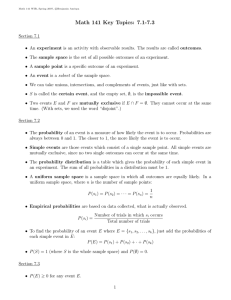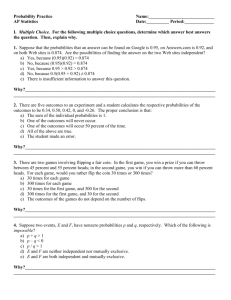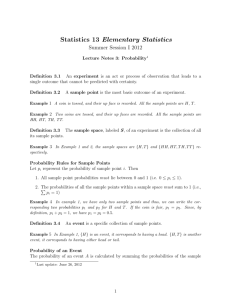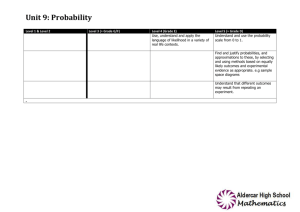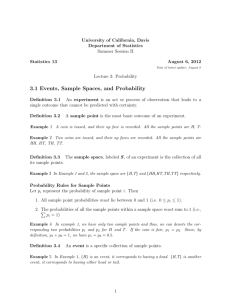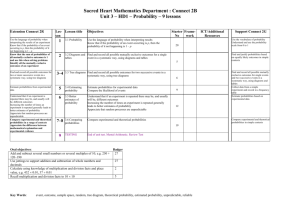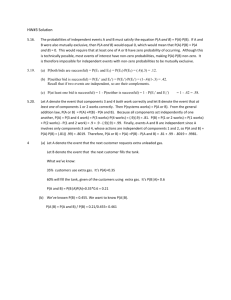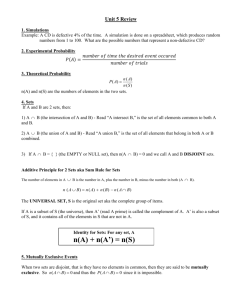Study Guide for Chapter 4
advertisement
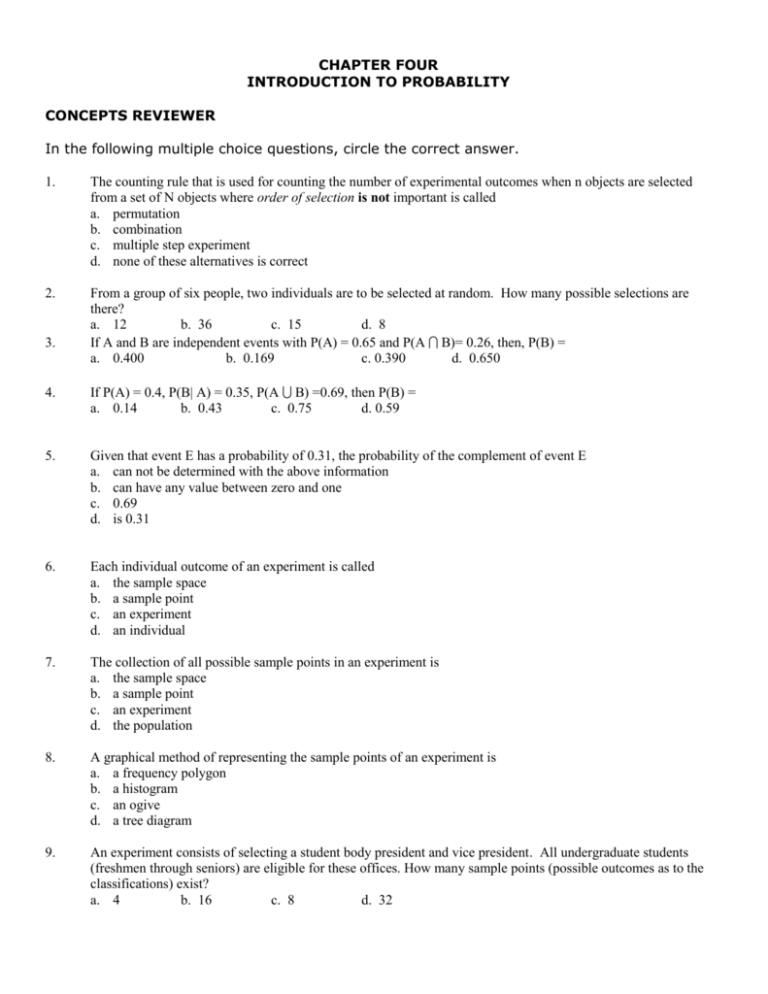
CHAPTER FOUR INTRODUCTION TO PROBABILITY CONCEPTS REVIEWER In the following multiple choice questions, circle the correct answer. 1. The counting rule that is used for counting the number of experimental outcomes when n objects are selected from a set of N objects where order of selection is not important is called a. permutation b. combination c. multiple step experiment d. none of these alternatives is correct 2. From a group of six people, two individuals are to be selected at random. How many possible selections are there? a. 12 b. 36 c. 15 d. 8 If A and B are independent events with P(A) = 0.65 and P(A B)= 0.26, then, P(B) = a. 0.400 b. 0.169 c. 0.390 d. 0.650 3. 4. If P(A) = 0.4, P(B| A) = 0.35, P(A B) =0.69, then P(B) = a. 0.14 b. 0.43 c. 0.75 d. 0.59 5. Given that event E has a probability of 0.31, the probability of the complement of event E a. can not be determined with the above information b. can have any value between zero and one c. 0.69 d. is 0.31 6. Each individual outcome of an experiment is called a. the sample space b. a sample point c. an experiment d. an individual 7. The collection of all possible sample points in an experiment is a. the sample space b. a sample point c. an experiment d. the population 8. A graphical method of representing the sample points of an experiment is a. a frequency polygon b. a histogram c. an ogive d. a tree diagram 9. An experiment consists of selecting a student body president and vice president. All undergraduate students (freshmen through seniors) are eligible for these offices. How many sample points (possible outcomes as to the classifications) exist? a. 4 b. 16 c. 8 d. 32 10. 11. Three applications for admission to a local university are checked, and it is determined whether each applicant is male or female. The number of sample points in this experiment is a. 2 b. 4 c. 6 d. 8 Assume your favorite football team has 2 games left to finish the season. The outcome of each game can be win, lose or tie. The number of possible outcomes is a. 2 b. 4 c. 6 d. 9 12. Each customer entering a department store will either buy or not buy some merchandise. An experiment consists of following 3 customers and determining whether or not they purchase any merchandise. The number of sample points in this experiment is a. 2 b. 4 c. 6 d. 8 13. An experiment consists of tossing 4 coins successively. The number of sample points in this experiment is a. 16 b. 8 c. 4 d. 2 14. Any process that generates well-defined outcomes is a. an event b. an experiment c. a sample point d. a sample space 15. The sample space refers to a. any particular experimental outcome b. the sample size minus one c. the set of all possible experimental outcomes d. an event 16. In statistical experiments, each time the experiment is repeated a. the same outcome must occur b. the same outcome can not occur again c. a different outcome may occur d. a different out come must occur 17. When the assumption of equally likely outcomes is used to assign probability values, the method used to assign probabilities is referred to as the a. relative frequency method b. subjective method c. probability method d. classical method 18. When the results of experimentation or historical data are used to assign probability values, the method used to assign probabilities is referred to as the a. relative frequency method b. subjective method c. classical method d. posterior method 19. A method of assigning probabilities based upon judgment is referred to as the a. relative method b. probability method c. classical method d. subjective method 20. A sample point refers to the a. numerical measure of the likelihood of the occurrence of an event b. set of all possible experimental outcomes c. individual outcome of an experiment d. sample space 21. A graphical device used for enumerating sample points in a multiple-step experiment is a a. bar chart b. pie chart c. histogram d. None of these alternatives is correct. 22. An experiment consists of three steps. There are four possible results on the first step, three possible results on the second step, and two possible results on the third step. The total number of experimental outcomes is a. 9 b. 14 c. 24 d. 36 Events that have no sample points in common are a. independent events b. posterior events c. mutually exclusive events d. complements 23. 24. Initial estimates of the probabilities of events are known as a. sets b. posterior probabilities c. conditional probabilities d. prior probabilities 25. Two events with nonzero probabilities a. can be both mutually exclusive and independent b. can not be both mutually exclusive and independent c. are always mutually exclusive d. are always independent
